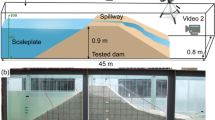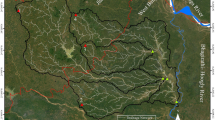Abstract
The loess hilly area consists of a slope–gully system, which promotes erosion; as such. it is one of the most intensely eroded areas in the world. The construction of check dams can effectively control water and soil loss of slope gullies. However, existing studies focus on the benefits of intercepting runoff and sediments at dam sites, while ignoring the change law of hydrological processes with respect to progressing dam land sedimentation. Moreover, past studies focus on the “runoff–sediment” or “flood–sediment” relationships, but rarely consider the “hydrodynamics–runoff” and “hydrodynamics–sediment” dynamics. Therefore, in this study, we developed five physical models of slope–gully systems for dam land sedimentation depths of 0, 1, 2, 3, and 4 m, in order to explore the effects of sedimentation on runoff–sediment–hydrodynamic processes. The runoff and sediment yield of the slope–gully system decreased with increasing siltation depth. The spatial and temporal distributions of the hydrodynamic parameters were different. The Reynolds number (Re), runoff energy consumption (ΔE), and runoff power (P) increased with rainfall time, whereas runoff shear stress (τ) and Froude number (Fr) did not show a significant trend over time. Re and ΔE could better describe the runoff process of the slope–gully system, while P and ΔE could better simulate the sedimentation process. Notably, our study can provide a scientific basis for establishing effective erosion prediction models to estimate the water erosion process of slope–gully systems.








Similar content being viewed by others
Data Availability
The data of this research are available from the corresponding author, upon reasonable request.
References
Bai L, Shi P, Li Z, Li P, Zhao Z, Dong J, Cui L (2022) Grass coverage and the runoff path length decreased by sedimentation have synergistic effects on runoff and sediment yields in a slope-gully system, revealed by rainfall simulation experiments. CATENA 218:106577. https://doi.org/10.1016/j.catena.2022.106577
Bombino G, Gurnell A, Tamburino V, Zema D, Zimbone S (2009) Adjustments in channel form, sediment calibre and vegetation around check-dams in the headwater reaches of mountain torrents, Calabria, Italy. Earth Surf Proc Land 34(7):1011–1021. https://doi.org/10.1002/esp.1791
Bryan R (2000) Soil erodibility and processes of water erosion on hillslope. Geomorphology 32(3–4):385–415. https://doi.org/10.1016/s0169-555x(99)00105-1
Feng Z, Li Z, Shi P, Li P, Wang T, Duan J (2021) Impact of sedimentation by check dam on the hydrodynamics in the channel on the Loess Plateau of China. Nat Hazards 107(1):953–969. https://doi.org/10.1007/s11069-021-04617-9
Fu B, Wang S, Liu Y, Liu J, Liang W, Miao C (2017) Hydrogeomorphic ecosystem responses to natural and anthropogenic changes in the loess plateau of China. Annu Rev Earth Pl Sc 45(1):223–243. https://doi.org/10.1146/annurev-earth-063016-020552
Gao G, Fu B, Zhang J, Ma Y, Sivapalan M (2018) Multiscale temporal variability of flow-sediment relationships during the 1950s–2014 in the Loess Plateau, China. J Hydrol 563:609–619. https://doi.org/10.1016/j.jhydrol.2018.06.044
Guyassa E, Frankl A, Zenebe A, Poesen J, Nyssen J (2017) Effects of check dams on runoff characteristics along gully reaches, the case of Northern Ethiopia. J Hydrol 545:299–309. https://doi.org/10.1016/j.jhydrol.2016.12.019
IUSS Working Group WRB (2006) World Reference Base for Soil Resources 2006 World Soil Resources Reports No 103. FAO, Rome
Knapen A, Poesen J, Govers G, Gyssels G, Nachtergaele J (2007) Resistance of soils to concentrated flow erosion: a review. Earth-Sci Rev 80(1–2):75–109. https://doi.org/10.1016/j.earscirev.2006.08.001
Li M, Yao W, Ding W, Yang J, Chen J (2009) Effect of grass coverage on sediment yield in the hillslope-gully side erosion system. J Geogr Sci 19(3):321–330. https://doi.org/10.1007/s11442-009-0321-8
Li E, Mu X, Zhao G, Gao P, Sun W (2017) Effects of check dams on runoff and sediment load in a semi-arid river basin of the Yellow River. Stoch Env Res Risk A 31(7):1791–1803. https://doi.org/10.1007/s00477-016-1333-4
Li P, Xu G, Lu K, Zhang X, Shi P, Bai L, Ren Z, Pang G, Xiao L, Gao H, Pan M (2019a) Runoff change and sediment source during rainstorms in an ecologically constructed watershed on the Loess Plateau, China. Sci Total Environ 664:968–974. https://doi.org/10.1016/j.scitotenv.2019.01.378
Li Z, Yang L, Wang G, Hou J, Xin Z, Liu G, Fu B (2019b) The management of soil and water conservation in the Loess Plateau of China: Present situations, problems, and counter-solutions (in Chinese). Acta Ecol Sin 39(20):7398–7409. https://doi.org/10.5846/stx6201909021821
Li L, Wu K, Jiang E, Yin H, Wang Y, Tian S, Dang S (2021) Evaluating runoff-sediment relationship variations using generalized additive models that incorporate reservoir indices for check dams. Water Resour Manag 35(11):3845–3860. https://doi.org/10.1007/s11269-021-02928-x
Li X, Xiao J, Chai N, Jin Z (2023) Controlling mechanism and water quality assessment of arsenic in China’s Yellow River Basin. J Clean Prod 418:137953. https://doi.org/10.1016/j.jclepro.2023.137953
Matomela N, Li T, Ikhumhen H (2020) Siting of rainwater harvesting potential sites in arid or semi-arid watersheds using GIS-based techniques. Environ Process 7:631–652. https://doi.org/10.1007/s40710-020-00434-7
Polyakov V, Nichols M, McClaran M, Nearing M (2014) Effect of check dams on runoff, sediment yield, and retention on small semiarid watersheds. J Soil Water Conserv 69(5):414–421. https://doi.org/10.2489/jswc.69.5.414
Ran Q, Tang H, Wang F, Gao J (2021) Numerical modelling shows an old check-dam still attenuates flooding and sediment transport. Earth Surf Proc Land 46(8):1549–1567. https://doi.org/10.1002/esp.5123
Shi P, Zhang Y, Ren Z, Yu Y, Li P, Gong J (2019) Land-use changes and check dams reducing runoff and sediment yield on the Loess Plateau of China. Sci Total Environ 664:984–994. https://doi.org/10.1016/j.scitotenv.2019.01.430
Shi P, Li P, Li Z, Sun J, Wang D, Min Z (2022) Effects of grass vegetation coverage and position on runoff and sediment yields on the slope of Loess Plateau, China. Agr Water Manage 259:107231. https://doi.org/10.1016/j.agwat.2021.107231
Su Y, Li P, Ren Z, Xiao L, Wang T, Zhang Y (2020) Slope erosion and hydraulics during thawing of the sand-covered Loess Plateau. Water-Sui 12(9):2461. https://doi.org/10.3390/w12092461
Tang H, Pan H, Ran Q (2020) Impacts of Filled Check Dams with Different Deployment Strategies on the Flood and Sediment Transport Processes in a Loess Plateau Catchment. Water-Sui 12(5):1319. https://doi.org/10.3390/w12051319
Wang T, Li P, Hou J, Li Z, Ren Z, Cheng S, Xu G, Su Y, Wang F (2018) Response of the meltwater erosion to runoff energy consumption on loessal slopes. Water-Sui 10(11):1522. https://doi.org/10.3390/w10111522
Wang T, Hou J, Li P, Zhao J, Li Z, Matta E, Ma L, Hinkelmann R (2021) Quantitative assessment of check dam system impacts on catchment flood characteristics–a case in hilly and gully area of the Loess Plateau, China. Nat Hazards 105(3):3059–3077. https://doi.org/10.1007/s11069-020-04441-7
Xu Y, Fu B, He C (2013) Assessing the hydrological effect of the check dams in the Loess Plateau, China, by model simulations. Hydrol Earth Syst Sc 17(6):2185–2193. https://doi.org/10.5194/hess-17-2185-2013
Yazdi J, Sabbaghian Moghaddam M, Saghafian B (2018) Optimal design of check dams in mountainous watersheds for flood mitigation. Water Resour Manag 32:4793–4811. https://doi.org/10.1007/s11269-018-2084-4
Yin C, Wang J, Yu X, Li Y, Yan D, Jian S (2022) Definition of Extreme Rainfall Events and Design of Rainfall Based on the Copula Function. Water Resour Manag 36(10):3759–3778. https://doi.org/10.1007/s11269-022-03229-7
Yuan S, Li Z, Chen L, Li P, Zhang Z (2022) Influence of check dams on flood hydrology across varying stages of their lifespan in a highly erodible Catchment, Loess Plateau of China. Catena 210:105864. https://doi.org/10.1016/j.catena.2021.105864
Zhang X, Yu G, Li Z, Li P (2014) Experimental study on slope runoff, erosion and sediment under different vegetation types. Water Resour Manag 28(9):2415–2433. https://doi.org/10.1007/s11269-014-0603-5
Zhang J, Yang M, Zhang F, Li Y (2019) Fingerprinting sediment sources in the water-wind erosion crisscross region on the Chinese Loess Plateau. Geoderma 337:649–663. https://doi.org/10.1016/j.geoderma.2018.10.024
Zhang J, Yang M, Zhang F, Tang Y, Wang X, Wang Y (2020) Revealing soil erosion characteristics using deposited sediment sources in a complex small catchment in the wind-water erosion crisscross region of the Chinese Loess Plateau. Geoderma 379:114634. https://doi.org/10.1016/j.geoderma.2020.114634
Zhao Z, Shi P, Bai L, Dong J, Li Z, Li P, Wang W, Cui L (2024) Vegetation patterns affect soil aggregate loss during water erosion. Land Degrad Dev 35(3):936–948. https://doi.org/10.1002/ldr.4962
Zheng M, Yang J, Qi D, Sun L, Cai Q (2012) Flow–sediment relationship as functions of spatial and temporal scales in hilly areas of the Chinese Loess Plateau. Catena 98:29–40. https://doi.org/10.1016/j.catena.2012.05.013
Zhu B, Zhou Z, Li Z (2021) Soil erosion and controls in the slope-gully system of the loess plateau of china: a review. Front Env Sci-Switz 9:136. https://doi.org/10.3389/fenvs.2021.657030
Funding
This work was supported by the National Natural Science Foundation of China (42307447, 42077073, 42373063, and 52379082).
Author information
Authors and Affiliations
Contributions
Material preparation and project administration were performed by Peng Shi, Zhanbin Li, and Peng Li. Conceptualization and supervision were performed by Lulu Bai and Peng Shi. Data collection was performed by Lulu Bai, Zhun Zhao, Jingbin Dong, Tanbao Li, Jingmei Sun, and Dejun Wang. The first draft of the manuscript was written by Lulu Bai and Peng Shi commented on previous versions of the manuscript.
Corresponding author
Ethics declarations
Ethical Approval
Not applicable.
Consent to Participate
All authors agreed to and participated in the study.
Consent to Publish
All authors read and approved the final manuscript.
Competing Interests
The authors have no relevant financial or non-financial interests to disclose.
Additional information
Publisher's Note
Springer Nature remains neutral with regard to jurisdictional claims in published maps and institutional affiliations.
Rights and permissions
Springer Nature or its licensor (e.g. a society or other partner) holds exclusive rights to this article under a publishing agreement with the author(s) or other rightsholder(s); author self-archiving of the accepted manuscript version of this article is solely governed by the terms of such publishing agreement and applicable law.
About this article
Cite this article
Bai, L., Shi, P., Li, Z. et al. Correlation Between Water Erosion and Hydraulics of Slope–Gully Systems According to Check Dam Siltation Depth. Water Resour Manage (2024). https://doi.org/10.1007/s11269-024-03827-7
Received:
Accepted:
Published:
DOI: https://doi.org/10.1007/s11269-024-03827-7




